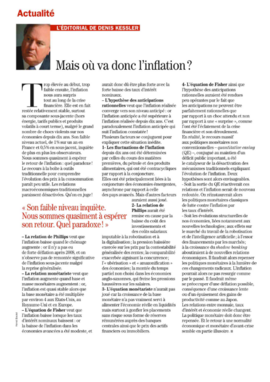So where is inflation going? - EDITORIAL FOR CHALLENGES BY DENIS KESSLER
Chairman & CEO of SCOR, Denis Kessler publishes an editorial piece in the French weekly Challenges, covering economic, political and financial current events in France and worldwide.
November 9, 2017

Too high at first, and then too low, inflation surprised us throughout the financial crisis. It has actually stayed relatively stable since then, particularly its core component (excluding energy, public-sector prices and short-term, volatile products), despite the large number of violent shocks that have hit our economies over the past ten years. Its current low level of 1.0% over one year in France – with a core rate of 0.5% – is becoming an increasing concern for observers. We’re almost hoping for the return of inflation: how ironic!
The traditional toolkit appears to be of little use when it comes to understanding consumer price developments. Traditional macroeconomic relationships seem to have been deactivated. Judge for yourselves!
- the Phillips curve holds that inflation falls when unemployment rises: yet there was no strong deflation after 2008 and today we see no significant rise in core inflation, despite the general recovery;
- according to monetarist theory, inflation rises when the monetary base and the money supply rise: yet inflation is virtually stable, even though there has been a near fourfold increase in the monetary base in the US, the UK and Europe;
- the Fisher equation holds that inflation falls when nominal interest rates fall: yet the drop in inflation in advanced economies has been slight, and should have been more significant given the sharp decrease in nominal interest rates;
- according to the rational expectations hypothesis, actual inflation converges towards its expected level: yet expected inflation has been higher than actual inflation for the past ten years. Paradoxically, expected inflation is following recorded inflation!
This unprecedented situation is due to a combination of several factors.
(1) Fluctuations in inflation over the past ten years have been largely determined by fluctuations in the price of commodities, oil and food, which have been countercyclical. These price fluctuations have been linked mainly to the economic situation in emerging market economies, which is out of sync with the situation in advanced countries, although other factors have also contributed.
(2) The Phillips curve has been called into question by the fall in investment and labor costs due to robotization and digitalization, by downward pressure on prices due to the pervasive contestability of economic rents or excess profits, by sharper competition brought about by heightened comparability, by the “uberization” and “amazonification” of economies, by the rise in involuntary part-time work in Anglo-Saxon economies, which is hampering upward pressure on salaries, and so on.
(3) The monetarist equation has not come into play because the growth of the monetary base has not really fed the real economy with cash; rather it has mainly served to inflate risk-free investments in the form of remunerated central bank reserves, as well as inflating the price of financial and real estate assets.
(4) The Fisher equation and the rational expectations hypothesis have been rendered ineffective by the fact that expectations can only be totally rational in relation to an expected shock, not in relation to a “surprise” like the eruption and unfolding of the financial crisis.
In reality, massive recourse to unconventional monetary policy such as Quantitative Easing, combined with continued significant public debt, has deactivated the traditional mechanics of inflation. This leaves two possible scenarios:
- either the exit from QE will reactivate these economic relationships, and inflation, having previously been desired, will be feared once again. Traditional monetary policies that limit inflation through interest rates would then be reinstated.
- or the structural changes to our economies - particularly those linked to new technology, to the impact on the labor market of robotization and artificial intelligence, to the boom in capital market financing, to the growth of shadow banking, and so on – will lead to new economic relationships. We would then need to rethink monetary policy in the light of these new radical changes, in terms of production, trade and the financing of economies. In this scenario, inflation could not resurface as it has done in the past. We would even have to consider the possibility of deflation, which is a notable consequence of slow growth or the depletion of productivity gains. The Japanese example comes to mind.
The world is changing. Monetary policy therefore needs to be reworked, taking account of all the changes currently underway. The relationships between money, interest rates and the real economy are changing. And a return to full, pre-crisis economic and monetary “normality” seems, to a certain extent, illusory.
